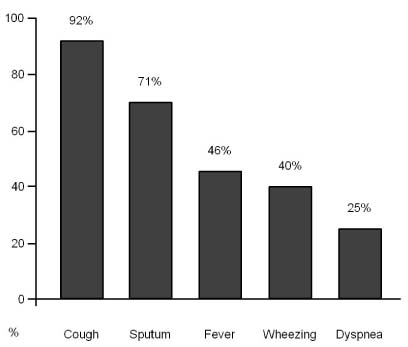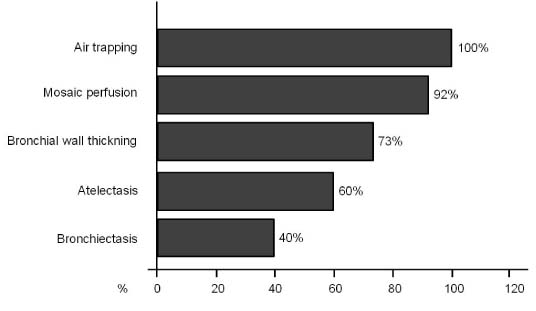Pediatr Allergy Respir Dis.
2012 Dec;22(4):397-403.
A Clinical Approach of Post-Infectious Bronchiolitis Obliterans Using the Results of High Resolution Computed Tomography
- Affiliations
-
- 1Department of Pediatrics, Yonsei University College of Medicine, Seoul, Korea. kekim@yumc.yonsei.ac.kr
- 2Department of Radiology, Yonsei University College of Medicine, Seoul, Korea.
Abstract
- PURPOSE
Bronchiolitis obliterans (BO) is a type of chronic obstructive lung disease. In children, the most common presentation is a post infectious origin. The aim of this study was to determine the clinical features, etiology, and radiologic findings of post infectious BO, which was diagnosed by high resolution computed tomography (HRCT). The results were then compared to those of the control group.
METHODS
We diagnosed 52 children with BO by a review of all performed HRCT findings at Severance Children's Hospital between January 2007 and March 2011. A retrospective study was conducted to define the clinical features, etiology, symptoms, and radiologic findings of post infectious BO. Sixty-five children who were diagnosed with lower respiratory infection confirmed by HRCT were defined as the control group for comparison with post infectious BO patients.
RESULTS
The mean age of the patients at the time of diagnosis with BO was 41.3+/-5.9 months, and that of the control group was 57.1+/-5.1 months. The initial insult age of BO patients was 14.6+/-2.8 months, and that of the control group was 50.9+/-5.0 months. The frequency of previous admissions due to lower respiratory infection was relatively higher in BO patients than the control group.
CONCLUSION
The results suggest that the development of post infectious BO should be early suspected and HRCT should be performed in children with a recurrent admission history of lower respiratory infection, especially in those younger than 2 years of age. Furthermore, continued management of prevent additional infection should be conducted.
MeSH Terms
Figure
Reference
-
1. Mauad T, Dolhnikoff M. Sao Paulo Bronchiolitis Obliterans Study Group. Histology of childhood bronchiolitis obliterans. Pediatr Pulmonol. 2002. 33:466–474.
Article2. Kurland G, Michelson P. Bronchiolitis obliterans in children. Pediatr Pulmonol. 2005. 39:193–208.
Article3. Castro-Rodriguez JA, Daszenies C, Garcia M, Meyer R, Gonzales R. Adenovirus pneumonia in infants and factors for developing bronchiolitis obliterans: a 5-year follow-up. Pediatr Pulmonol. 2006. 41:947–953.
Article4. Laraya-Cuasay LR, DeForest A, Huff D, Lischner H, Huang NN. Chronic pulmonary complications of early influenza virus infection in children. Am Rev Respir Dis. 1977. 116:617–625.
Article5. Chiu CY, Wong KS, Huang YC, Lin TY. Bronchiolitis obliterans in children: clinical presentation, therapy and long-term follow-up. J Paediatr Child Health. 2008. 44:129–133.
Article6. Welliver RC, Wong DT, Sun M, McCarthy N. Parainfluenza virus bronchiolitis. Epidemiology and pathogenesis. Am J Dis Child. 1986. 140:34–40.7. Kim CK, Chung CY, Kim JS, Kim WS, Park Y, Koh YY. Late abnormal findings on high-resolution computed tomography after Mycoplasma pneumonia. Pediatrics. 2000. 105:372–378.
Article8. Fischer GB, Sarria EE, Mattiello R, Mocelin HT, Castro-Rodriguez JA. Post infectious bronchiolitis obliterans in children. Paediatr Respir Rev. 2010. 11:233–239.
Article9. Kim CK, Kim SW, Kim JS, Koh YY, Cohen AH, Deterding RR, et al. Bronchiolitis obliterans in the 1990s in Korea and the United States. Chest. 2001. 120:1101–1106.
Article10. Zhang L, Irion K, da Silva Porto N, Abreu e Silva F. High-resolution computed tomography in pediatric patients with postinfectious bronchiolitis obliterans. J Thorac Imaging. 1999. 14:85–89.
Article11. Chan PW, Muridan R, Debruyne JA. Bronchiolitis obliterans in children: clinical profile and diagnosis. Respirology. 2000. 5:369–375.
Article12. Zhang L, Irion K, Kozakewich H, Reid L, Camargo JJ, da Silva Porto N, et al. Clinical course of postinfectious bronchiolitis obliterans. Pediatr Pulmonol. 2000. 29:341–350.
Article13. Mattiello R, Mallol J, Fischer GB, Mocelin HT, Rueda B, Sarria EE. Pulmonary function in children and adolescents with postinfectious bronchiolitis obliterans. J Bras Pneumol. 2010. 36:453–459.14. Fan LL, Kozinetz CA. Factors influencing survival in children with chronic interstitial lung disease. Am J Respir Crit Care Med. 1997. 156(3 Pt 1):939–942.
Article15. Hong SJ, Kim BS, Ahn KM, Lee SI, Kim KE, Lee KY, et al. Multicenter study of bronchiolitis obliterans in Korean children. Pediatr Allergy Respir Dis. 2002. 12:136–145.16. Seo HK, Kim HY, Yang HK, Shin SH, Lee BK, Kim SH, et al. Bronchiolitis obliterans in children: a single institution experience. Pediatr Allergy Respir Dis. 2011. 21:123–130.
Article17. Colom AJ, Teper AM, Vollmer WM, Diette GB. Risk factors for the development of bronchiolitis obliterans in children with bronchiolitis. Thorax. 2006. 61:503–506.
Article18. Colom AJ, Teper AM. Clinical prediction rule to diagnose post-infectious bronchiolitis obliterans in children. Pediatr Pulmonol. 2009. 44:1065–1069.
Article19. Kelly K, Hertz MI. Obliterative bronchiolitis. Clin Chest Med. 1997. 18:319–338.
Article20. Nagai H, Shishido H, Yoneda R, Yamaguchi E, Tamura A, Kurashima A. Long-term low-dose administration of erythromycin to patients with diffuse panbronchiolitis. Respiration. 1991. 58:145–149.
Article21. Hardy KA, Schidlow DV, Zaeri N. Obliterative bronchiolitis in children. Chest. 1988. 93:460–466.
Article22. Moonnumakal SP, Fan LL. Bronchiolitis obliterans in children. Curr Opin Pediatr. 2008. 20:272–278.
Article
- Full Text Links
- Actions
-
Cited
- CITED
-
- Close
- Share
- Similar articles
-
- A case of bronchiolitis obliterans developed after adenovirus type 7 pneumonia
- Clinical Characteristics of Post-Infectious Bronchiolitis Obliterans
- Diffuse Micronodular Pattern of Bronchiolitis Obliterans Organizing Pneumonia: A Case Report
- A case of bronchiolitis obliterans organizing pneumonia in patient with systemic lupus erythematosus
- A Case of Bronchiolitis Obliterans after Exposure to Nitrogen Dioxide



